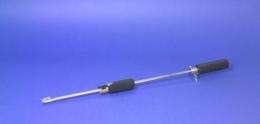Minimally invasive surgeries: Laser suturing

Surgeries with the endoscope are exacting and require special capabilities of the surgeon. The suturing of the tissue and the setting of the knots, in particular, is very complicated due to the lack of space for movement. A new, minimally invasive suturing tool simplifies the procedure. In the future, the suture material will no longer be knotted, but welded with a laser. The device will be displayed at the MEDTEC Fair in Stuttgart, from March 22-24, 2011
More and more often, abdominal surgeries are being carried out in a minimally invasive manner. A small incision in the abdominal wall is sufficient for the surgeon to be able to insert the instrument and make the organs visible with an endoscope. This technique is gentler and does not stress the body as much as traditional surgeries do. However, these minimally invasive surgeries pose a special challenge to the surgeons. In particular, the suturing – meaning joining the tissue with needle and suture material - demands great skill and dexterity. Very often, piercing the tissue and tying the knots is difficult – after all, the surgeons must perform surgeries in very tight quarters, while having very little room to move. Unlike when sewing textiles, a knot must be made after every stitch, which is a very exacting process that stresses the patient and can cause a number of complications. If the suture is too tight, there is the danger of a minor hemorrhage. In addition, the suture material can cut into the tissue and strangulate vessels. In worst cases the tissue may even die. However, if the suture is too loose, there may be bleeding at the edges of the wound.
Currently, setting the correct suture tension depends on the experience of the surgeon. He must subjectively estimate the optimum tension – and do this anew for every surgery. He does not have access to a reproducible, standardized setting. In the future, a minimally invasive suturing instrument shall make suturing easier. The researchers of the Fraunhofer Institute for Production Technology IPT in Aachen have developed this instrument within the scope of the InnoNet project "The Suture" (see below). In a new, semi-automatic process the suturing instrument enables the surgeon to connect the suture material with a previously set, predefined tension. Not only does it shorten the suturing process with respect to time, it also hastens the healing of the wound. The patient is able to recover more quickly. "With our new device, the edges of the wound can be joined quickly and safely, since it automatically ensures the optimum tension for the suture. The surgeon no longer has to deal with that. In the future, the difficult task of knotting the ends of the suture material will no longer be necessary, since they simply will be welded with the laser," explains Dipl.-Ing. Adrian Schütte, a scientist at the IPT.
The idea for this process is based on the laser welding process for plastics. During this process, two thermo-plastic pieces to be lasered together are welded together by means of laser energy. Adrian Schütte said: "In our case, the suture material is one of the two pieces to be lasered together, the other one is the sleeve. It is located in the tip of the new suturing device, which has a diameter of ten millimeters."
But, how does the new process work? First, the surgeons access the abdominal cavity through a small tube – the experts call it a trocar. After they pierce the tissue with a needle, they pull the end of the suture material out with the surgical forceps, through the trocar, and clip it into the sleeve. A defined tension can be set for the suture by pushing the sleeve through the trocar and simultaneously tensioning the suture. Once the desired tension has been achieved, the suture material is welded to the sleeve by laser. The laser is located at the end of the suturing instrument, the laser beam is sent via the light conducting fiber through the instrument. The superfluous suturing material is cut off behind the sleeve. And, as a last step, the surgeons pull the suturing instrument out through the trocar. After the lasering, the sleeve remains in the abdominal cavity. Schütte remarked: "Currently, the sleeve consists of polypropylene, in the future we would like to manufacture it from resorbing materials."
Together with the InnoNet Project Partners (see below), the scientist and his team were already able to successfully carry out the suturing process during tests in the laboratory. The expert remarked: "We were able to achieve the best results with a suture tension of zero to five Newton and a lasering time of 0.1 seconds." The preclinical studies are slated to start in the course of this year at the Aachen university hospital. To begin with, the suturing instrument will be utilized for minimally invasive surgeries in the abdominal area. The researcher is convinced that it can also be adapted to keyhole surgeries of the heart. The researchers from the IPT will display a prototype of the minimally invasive suturing instrument at the MEDTEC Europe Fair in Stuttgart (Hall 11, Booth 6211) from March 22 - 24, 2011.

















